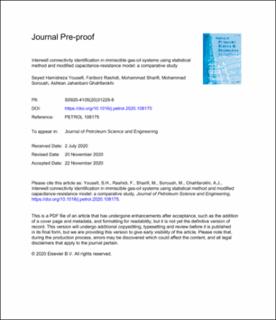| dc.contributor.author | Yousefi, Seyed Hamidreza | |
| dc.contributor.author | Rashidi, Fariborz | |
| dc.contributor.author | Sharifi, Mohammad | |
| dc.contributor.author | Soroush, Mohammad | |
| dc.contributor.author | Jahanbani Ghahfarokhi, Ashkan | |
| dc.date.accessioned | 2021-02-01T14:39:13Z | |
| dc.date.available | 2021-02-01T14:39:13Z | |
| dc.date.created | 2020-12-03T08:31:21Z | |
| dc.date.issued | 2020 | |
| dc.identifier.issn | 0920-4105 | |
| dc.identifier.uri | https://hdl.handle.net/11250/2725644 | |
| dc.description.abstract | Interwell connectivity identification between injector-producer well pairs and hydrocarbon production estimation are essential parameters in reservoir management, which can determine unrecovered oil volume and reservoir continuity. Although there are several published methods for determination of interwell connectivity in water-oil systems, there is no such comprehensive study on gas flooded reservoirs. Due to the high mobility of gas, interwell connectivity is a critical criterion in channelized, faulted and heterogeneous reservoirs for reservoir characterization, production optimization, infill drilling and performance predication. There are physical and statistical techniques to determine interwell connectivity mathematically and identify reservoir flow dynamics without using any operational activities. All methods are working with limited production data and unlike the numerical simulators, they are simple and do not require detailed data. In this paper, modified capacitance-resistance model (or M-CRM as a physical approach) and combination of least square support vector machine and multiple linear regression (as a statistical approach) are applied to two immiscible gas injection cases with different assumptions, and the results are compared. The results show that both methods are reliable in terms of validity, speed and flexibility. The physical approach (M-CRM) is more accurate for interwell connectivity prediction while the statistical method is more precise for producer total rate estimation. | en_US |
| dc.language.iso | eng | en_US |
| dc.publisher | Elsevier | en_US |
| dc.rights | Attribution-NonCommercial-NoDerivatives 4.0 Internasjonal | * |
| dc.rights.uri | http://creativecommons.org/licenses/by-nc-nd/4.0/deed.no | * |
| dc.title | Interwell connectivity identification in immiscible gas-oil systems using statistical method and modified capacitance-resistance model: a comparative study | en_US |
| dc.type | Peer reviewed | en_US |
| dc.type | Journal article | en_US |
| dc.description.version | acceptedVersion | en_US |
| dc.source.journal | Journal of Petroleum Science and Engineering | en_US |
| dc.identifier.doi | https://doi.org/10.1016/j.petrol.2020.108175 | |
| dc.identifier.cristin | 1855593 | |
| dc.description.localcode | "© 2020. This is the authors’ accepted and refereed manuscript to the article. Locked until 2.12.2022 due to copyright restrictions. This manuscript version is made available under the CC-BY-NC-ND 4.0 license http://creativecommons.org/licenses/by-nc-nd/4.0/ " | en_US |
| cristin.ispublished | false | |
| cristin.fulltext | postprint | |
| cristin.qualitycode | 2 | |

